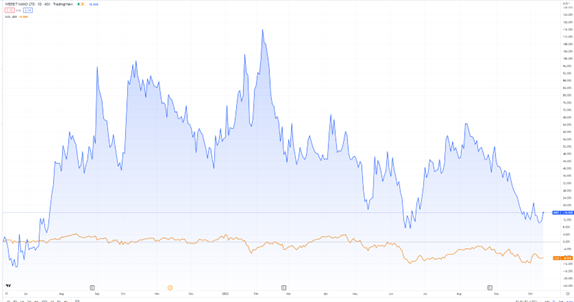On Thursday, Weebit Nano [ASX:WBT] said it’s made significant progress, with new results showing its ReRAM technology fits embedded and discrete applications.
WBT thinks this result ‘greatly increases the number of possible applications for Weebit’s technology’.
WBT shares were up 4.5% in late Thursday trade.
Year-to-date, WBT is down 25%:

www.TradingView.com
Weebit’s new ReRAM developments
On Thursday, Weebit announced noteworthy progress in its ReRAM technology.
The company achieved this milestone together with development partner CEA-Leti, a micro and nanotechnology pioneer.
Weebit reported that, together with CEA-Leti, it was able to show the potential of its ReRAM selector to achieve the densities required for ‘discrete chips using standard materials and tools’.
WBT thinks the selector technology, by fitting embedded applications, can enable ‘unprecedented non-volatile memory (NVM) densities for future system-on-chips (SoCs)’.
Why is this technology worthwhile to pursue commercially?
In Weebit’s words:
‘Developing cost-efficient selectors using only standard materials and tools is a significant challenge, but has the potential to further minimise manufacturing cost and complexity. While additional development is still required, this new selector technology could be easily integrated into any CMOS fab, potentially enabling the high-capacity memory arrays needed while keeping size and power to a minimum.’
Weebit’s CEO, Coby Hanoch, commented:
‘We have worked hard to create a ReRAM selector that can achieve high densities using fab-friendly materials and standard tools, and accomplishing this is a significant development for Weebit. Such a selector will make it easy and cost-effective for any foundry to integrate the technology into existing processes and offer it to their customers.
‘In addition, we’re breaking down a barrier by making it possible to use the same selector for both discrete and embedded applications. This is an important step forward on our roadmap for discrete products and is a compelling value proposition for companies developing advanced SoCs for applications like edge AI, which need a reliable, cost-effective replacement for embedded flash. “Ongoing selector development will be carried out in parallel to rolling out our embedded technology to mass production.”’
Next-gen tech and bitcoin’s march to US$1 million
Weebit considers itself a leading developer of next-generation semiconductor memory tech.
But semiconductor memory tech isn’t the only thing undergoing an upheaval.
You could argue that money itself is in the process of a technological revolution.
And Bitcoin [BTC] could be the next generation — or iteration — of money.
Yes, bitcoin has been hyped plenty.
But hype often follows substance — excitement at a potentially game-changing technological development or breakthrough.
Our leading crypto expert Ryan Dinse has just recently released a presentation on bitcoin, where it’s going, and why it’s so important.
He argues that bitcoin’s importance will grow so much that it could see an explosion in its price.
Ryan thinks bitcoin going to US$1 million by 2030 isn’t so far-fetched.
US$1 million by 2030?
It might sound ludicrous, especially as bitcoin is currently hovering around US$19,000 and is down 60% over the past 12 months.
But Ryan thinks the idea isn’t ludicrous. And he’s actually preparing for the next crypto bull market.
In this exclusive presentation he lays down his arguments for how bitcoin can hit US$1 million by 2030.
It’s worth a watch!
Regards,
Kiryll Prakapenka
For Money Morning

